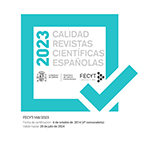Formas de legitimación de la violencia en TV
Resumen
La violencia en televisión muestra unos patrones que son generalmente aceptados por la sociedad que los recibe. La emisión de un episodio de violencia o de una agresión está contextuada de tal manera que al espectador ya le llega valorada de forma positiva o negativa. Esta valoración conforma unos patrones de legitimación característicos y diferenciados que hemos tratado de identificar en sus diferentes manifestaciones. Hemos recogido de forma aleatoria fragmentos de emisiones televisivas para analizar los diversos patrones legitimatorios de la violencia en televisión. La evaluación de la violencia necesita de tres factores que son la presentación de los agresores y las víctimas, la apreciación del daño y las consecuencias de la acción y la «cualificación» de las acciones. En las emisiones televisivas existe mucha legitimación de violencia, que va desde la no condena, a la justificación explícita y a la exaltación. La aceptación social de la violencia se observa mucho más en los programas de modalidad no realista, las películas y series, pero también alcanza a los informativos y reportajes. Eso sí, los marcos de legitimación en los programas no realistas son más amplios y menos ajustados a las normas de convivencia de un Estado de derecho.Descargas
Descarga artículo
Licencia
La revista Política y Sociedad, para fomentar el intercambio global del conocimiento, facilita el acceso sin restricciones a sus contenidos desde el momento de su publicación en la presente edición electrónica, y por eso es una revista de acceso abierto. Los originales publicados en esta revista son propiedad de la Universidad Complutense de Madrid y es obligatorio citar su procedencia en cualquier reproducción total o parcial. Todos los contenidos se distribuyen bajo una licencia de uso y distribución Creative Commons Reconocimiento 4.0 (CC BY 4.0). Esta circunstancia ha de hacerse constar expresamente de esta forma cuando sea necesario. Puede consultar la versión informativa y el texto legal de la licencia.











